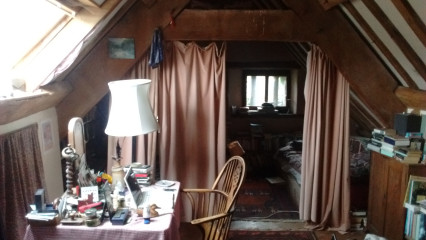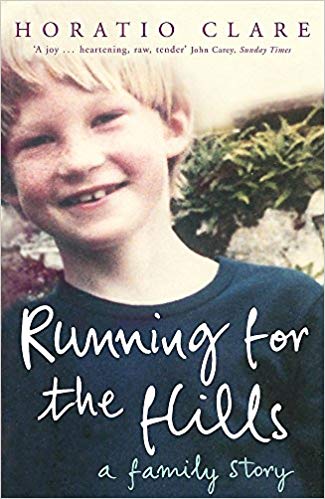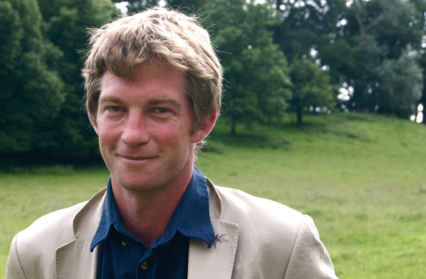Author and journalist Horatio Clare is next up in our Writers’ Room series. He worked at the BBC as a producer on Front Row (BBC Radio 4), Night Waves and The Verb (BBC Radio 3). Clare has written two memoirs, Running for the Hills and Truant: Notes from the Slippery Slope, a novella, The Prince’s Pen, and two works of travel and nature writing: A Single Swallow and Down to the Sea in Ships. He wrote and edited Sicily Through Writers’ Eyes. In 2015 he published Orison for A Curlew, a combination of travel and nature writing, and an acclaimed children’s book, Aubrey and the Terrible Yoot.

I wish this was the room in which I wrote; in fact, it is my room in our family home in Wales where I have written parts of all of my books, but never a complete manuscript. I have lived and written at thirty addresses since leaving school: three in York, three in Italy, twelve in London, five in Wales (one by the sea in Little Haven and one overlooking St David’s cathedral during the winter which was incredible strokes of fortune) and including a boat on Regent’s canal in London, where the shower was not just cold but on the towpath, in view of passersby.
I am often writing about the last place I was or the place before. So Running for the Hills, about growing up on the Black Mountains, was produced in a basement on the Kennington Road, at eye-level with the wheels of the Number 3 bus and within earshot of Big Ben, as least in the small hours.
A Single Swallow proved you do not need much infrastructure to be a writer: I wrote it in a spare room in Rochdale. There was a chair but no desk so in the end, I sat on the floor. If I had to pick one room in which to write everything else it would be the study of the villa in the Veneto where I wrote Down to the Sea in Ships. We rented the top floor but I had the use of the study on the ground floor, cool in summer, a fabulous dark room with relief maps of Italy on the walls and geraniums in boxes on the windowsills. I started my first children’s book there, Aubrey and the Terrible Yoot. It is set in the terrace in Yorkshire where we were then debating moving, and where I write now: my attic here is a smaller version of the Welsh attic in the picture. Part of the point of the book’s setting was to persuade me that a rainy valley in Yorkshire could be an exciting place for a child to live, and a bearable transition for his family to make, after the heaven of Italy.

But this room in Cwmdu has been home in a deep way since we moved there from the farm on the mountain where I grew up, which is a mile or so to the right of the picture. You cannot see them but there are swallows’ nests on the beams, a happy example of fate’s foreshadowing. My mother said the nests were one of the reasons she liked the house. I had no idea that following swallows would determine much of my adult life. I was pursuing them when I met Rebecca, the mother of our son. On the beam at the top of the shot, just out of sight, are the remains of the pair of shoes which carried me throughout the swallow journey, the length of Africa and Europe.
The skylight gives a good view of the hill on the other side of the valley, beyond which is Llangorse Lake. My room in Yorkshire also has a skylight. Slowly twisting clouds make the perfect view when searching for a word or an expression.
The desk is covered with an accretion of objects from different times and travels. There is a clay bottle full of feathers, a cigar case containing a fragment of rock from Namibia which is 1.2 billion years old, there are bracelets, postcards, a porcupine quill, a Parsee medallion, an inexplicable ashtray decorated with the coats of arms of Oxford colleges. There is a mirror on the desk but that is really to keep my eyes on the screen or the page; a friend painted it and it is covered with postcards. If I catch sight of myself I feel spurred to look away and work on. There are photographs of my family, including one beauty of my parents in about 1971, looking strikingly handsome and dressed not at all like the hill farmers they were trying to be. There is a large framed photograph of my sister, Janey, who died in 2011. I still do not know how to address her death in writing, though I hope I will one day. When it happened all I could do was sit in that chair and write her letters and poems.
All around but mostly out of shot are books. There is an order to them: below the far window is a bank of travel books; the ones you can see on the small cupboard on the right are French; on the floor below them is a combined shelf of biographies of the Romantics and poetry. It is a very cold room in winter, which is good for writing, and a lovely apple-smelling, drowsy warm place in summer, which is not.
In the bed behind the curtain I first fell in love with literature as an adult, reading Richard Holmes’ biography of Coleridge. My first near-adult piece of work, a college essay about Kubla Khan, I did at the desk, feeling the thrilling bite of having something to say and a way to say it. Many nights since I have read late in the chair or the bed, while the valley road fell silent, and the foxes and owls turned in.
It is still a boy’s room in some ways. There is a fishing rod on another beam and a tin of airgun pellets on the desk. I rather hope it will be my old man’s room, one day. It would be a lovely place to write a final chapter. But who knows? As my friend the vicar says, there are many things in the womb of time that will be delivered! I hope there are more rooms and more addresses to come.
Running for the Hills by Horatio Clare is available now.
Horatio Clare’s Writers’ Rooms piece is a part of a Wales Arts Review series.
For other articles included in this collection, go here.












